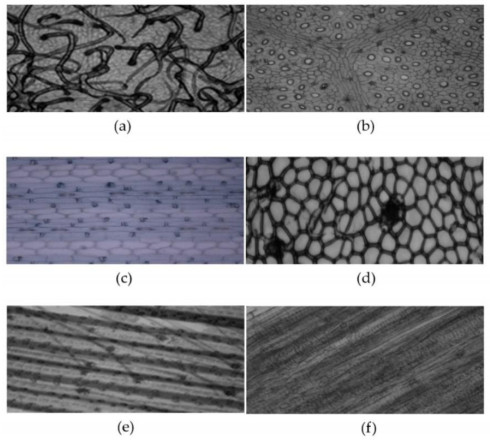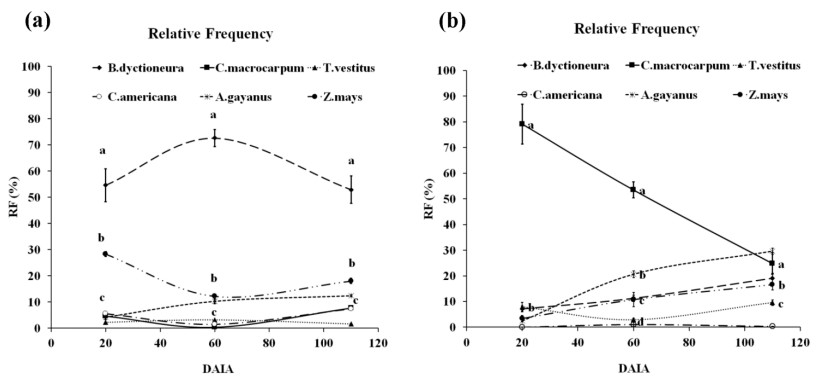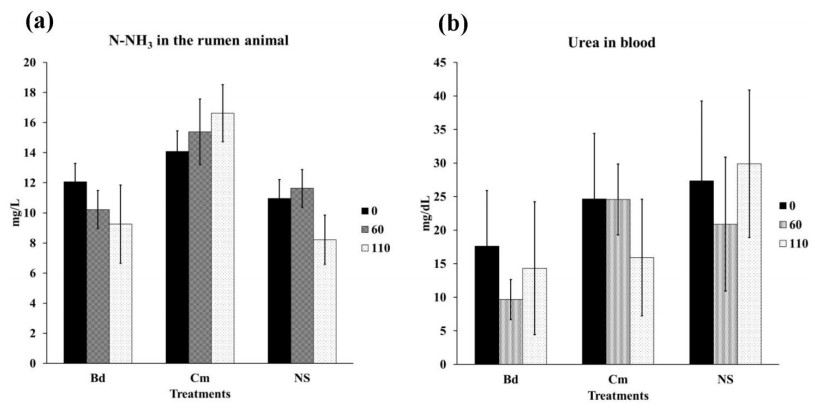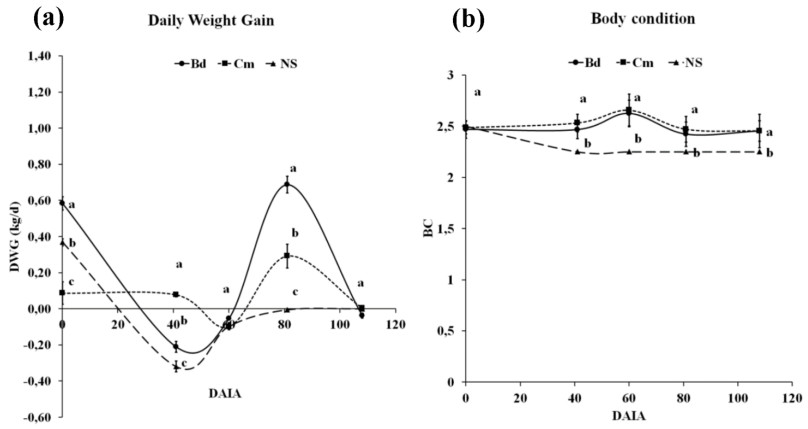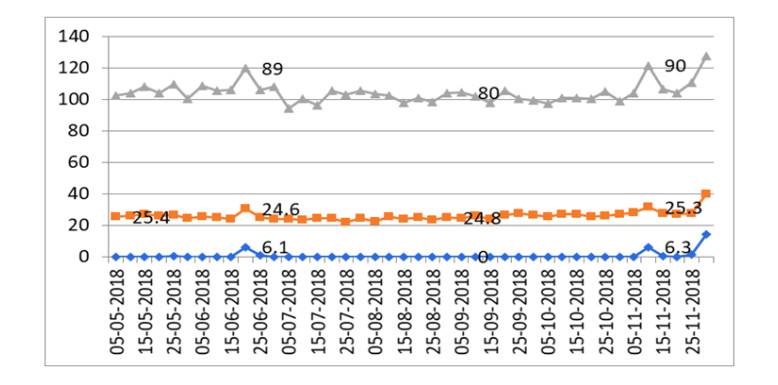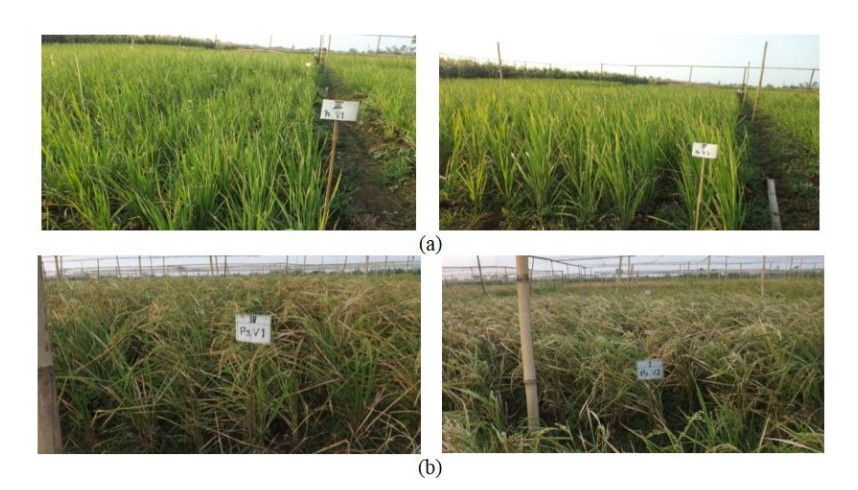1.
Introduction
The low nutritional quality of the native forages and the seasonality of the forage production are the main problems that livestock farms in the neotropical savannas have [1]. In addition, there are the limitation of the lack of enough forages management techniques, economic resources and infrastructure [2], the degradation of the native pasture areas [3] and the little sustainability of the pastures due to high lignification and short useful lifetime of the native forage [4]. Several of these problems are established on the ecological and productive scene of the savannas, characterized by the limited fertility of the soils and the climatic bi-seasonality: periods of six months of drought affecting the livestock feeding [5] because of the drastic change of bioability and quality of the native plants with forage potential [1]. So, the traditional form of management is the extensive cattle grazing and more recently the cereal-cattle production, where the animals are introduced to pasture the stubble in the dry season, after the crop harvest, looking for a more efficient use of the resources by the farmers. Even so, the forage offered during the grazing is still a problem, reinforcing at the moment the mix agroecosystems sustainability through the use of conservationist managements, which include the introduction of cover crops associated to cereal as a source of a better forage quality for the cattle [6].
Being the nutrition of the grazing cattle in the neotropical savanna a key factor, it is important to know, by evaluating the pasture, the quality and availability of the forage biomass [1], and the dynamic of the consumption by the cattle [7], since it changes with the climatic conditions, grazing regime, bromatology and digestibility [8]. As the digestibility means the portion of vegetal biomass digested by the animal (difference between the consumed food and the excreted quantity as stool) [9] it is also affected by the senescence and bromatological dynamic of the forage offered to the cattle during the grazing time [10]. At the moment of consumption, the animal selects what is offered (selectivity), where the preference, referring to the behavior or reaction of an animal in front of the plant [11], and the palatability or acceptance, referring to the intrinsic characteristics of the plant [12], influence the animal feeding and the functioning of the agroecosystem or ecosystem.
It must be noticed that these perturbations (herbivory) are the ones that mold the community structure of the grassland system [13] through the changes in the species richness, diversity and composition, canopy structure and morphological attributes of the plants. On the other hand, at the ecosystemic level, it influences the net primary productivity, the soil organic carbon, and others [14]. Both, floristic diversity [15] and structural diversity of the vegetal savanna ecosystem have been little considered in the studies related to the grazing and other vegetation disturbance ways, despite the importance that the space organization, the forage biomass and quality have to other trophic levels of the system.
The degradation process of the consumed material, which is initiated in the animal rumen, begins with the selectivity, during the defoliation by the cattle. The ruminants doing a pre-gastric fermentation are capable of doing a better use of the rich cellulose food by the action of microorganisms and protozoa in the rumen [16]. This capacity in the feeding of the ruminants with forage and cellulosic residues permits a more integrated management of the agroecosystem, which takes advantages of the resources that could not be used to human feeding [17]. Based on this, the more lignified maize residues and the low nutritional quality, added to perennial cover crops associated to the culture, which act as a better quality forage, constitutes a cattle feeding strategy in production systems; being able to affect the physiological response of the grazing cattle in the neotropical savannas during the intense dry season of these ecosystems. So, the digestibility of the maize stubble can be improved when it is associated to forage legume [18]. On the other hand, the pasture could increase the palatability of the pastures maintaining the agroecosystem production and offering soil protection [19].
However, the defoliation effect over the grassland depends on the pasture species and the land use intensity [20]. Being defoliation a selective process, an alteration of the species natural balance is produced, which affects the development of the plants. Besides, the intense cattle tread compacts the soil affecting the usual development of the plants roots and its capacity of absorption, specially to some species more sensitives to this mechanic factor, which is expressed on the nutritional quality of the pastures and the weight gain of cattle [21]. All these can be modulated by the size of the grazing area, the animal density and the pasture conditions [22]. Per se, the consumption and digestibility of pastures are multifactorial processes in the neotropical savannas pasture systems, whose soils are nutritional low quality [23].
Selectivity studies during the consumption of ruminants grazing showed that the feeding preferences frequency of the cattle are determined by microhistological analysis [24], among others; being very useful to assess the stomach contents and stool, where, adapted by [25], has been widely referred to the species selectivity and diets components of different herbivores [26].
Knowing the limited productive reality of the neotropical savannas, from the forage to cattle, said to affect the ruminants consumption and digestibility, the objectives were: (ⅰ) to evaluate the consumption and digestibility in ruminants during the grazing time when grass or legumes are associated to the maize culture in cereal-cattle production system; (ⅱ) to determine the selectivity variations by ruminants during herbivory in these agroecosystems through microhistological techniques; (ⅲ) to associate the consumption and digestibility patterns to the quantity and quality of the forage cover crops and the body condition of the cattle.
2.
Materials and method
2.1. Experimental area description
The research was done in well drained savanna ecosystems located in Venezuelan center-east plains, in the northern Orinoco river influence, specifically at La Iguana Experimental Station, geographically located at 8° 25’ N and 65° 25’ W, at 80–120 meters above sea level. This zone is characterized by having a climatic bi-seasonality with two very marked contrasting periods; a dry one, from November to May, and a rainy one, from July to October. The annual total precipitation is between 950 and 1,300 mm, and the monthly average temperatures between 26℃ and 30℃ [27].
The well-drained savannas or the Trachypogon savannas are the predominant ecosystems [28], characterized by big extensions of native grass, dominated by the Trachypogon y Axonopus genders, with dispersed trees of these species: Curatella
americana, Byrsonima crassifolia and Bowdichia virgilioides. Previous studies show the presence of twelve plant companion species in the productive systems that are developed at the experimental station; the ones with more presence are: Indigosfera lespedezioides, Waltheria americana, Eragrostis ciliaris and Trachypogon vestitus [27]. Now, the areas with introduced pastures have been increasing; where the genders Brachiaria,
among the grass, and legumes of the genders Centrosema y Calopogonium, are predominant. These pastures have better forage quality than native pasture.
The zone is physiographically located at a preserved high plateau, combined with aeolic deposition and some tertiary outcrop material, with slope between 1–3% and predominance of sandy soils (80%), being the Ustoxic Quartzipsamen the more extensive [29]. The soils are acid (pH 5.2), with high Fe and Al contents. The P (2 mg/kg), K (50 mg/kg), Ca (120 mg/kg) and organic matter (1.7%) are also low [29].
2.2. Management history
In a 10-ton area, since 2002, several assays were established for the agroecological management of well-drained savannas soils with maize-cattle production systems (Project G-200200398); using non-tillage to the maize culture associated with perennial cover crops of grass and legumes. The two first years constituted the cover crops establishment time, the legume Centrosema macrocarpum and the grass Brachiaria dyctioneura, being considered the natural vegetation of the savanna ecosystem as a control treatment. A basic fertilizer of 150-150-100 kg/ha of N-P2O5-K2O was added. In 2004, at the beginning of the rainy season, a first cut of the cover crops to non-tillage maize culture was conducted, leaving the cutted residuals as necromass coverage over the soil surface. A contact herbicide, paraquat, was used at a low dose of 2 L/ha (20% SL), in order to attenuate the regrowth of the cover crops giving advantage to maize-growing (HIMECA 3005). The cereal was sowed with a no tillage machine ©SEMEATO over the necromass. As a fertilizer alternative to the culture it, the phosphoric rock was used as a P source in a single application, the N was dosed in three fractions (0-15-30 days after the sowing, DAS) and the K in two doses (0–15 DAS). The cover crops were bounced again a few days after the cut. Once the maize harvest was made, at the beginning of the dry season, the cattle was introduced (Mautes), to be fed from the cover crops and the culture stubble for a 110 days period, coincident with the dry season.
2.3. Experimental design
The experimental design included the following treatments: Brachiaria dyctioneura (Bd), Centrosema macrocarpum (Cm) and the control, natural savanna vegetation (NS). The experimental design of the assay corresponded to big plots (400 × 15 m) by cover crop, for which a previous geostatistical study of space variability was performed [30,31], in order to use similarly heterogeneous soil areas, permitting the establishment the orientation and size of the plots constituting the paddocks [32].
The paddocks were established dividing the plots of each cover crop in two sectors. The dimensions of the paddocks were 200 × 15 m, with an estimated animal charge of 1.04 UA/ha. We worked with a total of 36 weaned calves, half-blood Criollo Limonero type with Cebu blood predominance, meaning a n = 16 by each introduced cover crop and in the case of the control (NS), we worked with four animals. Two weeks before introducing the calves to the paddocks, the animals were vaccinated, dewormed. They passed through an adaptation period to the available forage and the electric fences used in the assays as barriers to separate the paddocks [32].
2.4. Sampling method and sample preparation
A 50 cm diameter ring was used for the calculation of the total forage aerial biomass in which the vegetal material inside it over the soil surface which remained within the ring to the quantification of the. The same was thrown randomly a total of six times per big plot of cover crops (Bd, Cm) and control (NS) treatments, five times during the pasture: 0-41-60-81-110 days after being introduced the animals (DAIA). The material was dried in a stove at 40℃ for 72 h, weighted and separated later weighing the green leaf fraction [33]. Each biomass sample of the periods 0-60-110 DAIA was ground in a Wiley grinder to bromatological later analysis.
The daily weight gain (DWG) and body condition (BC) of each animal in all paddocks were evaluated at the same times, simultaneously, and using the same weighing time and scale,
In order to conform the reference collection to the test samples, we collected vegetal species in the paddock of the agroecosystems and the native savanna area, where the cattle grazed, which were later identified [34]. Equally, stool samples were taken directly from the rectus (1 kg approximately) of each of the bovines located at the paddocks at three times of the grazing cycle (20-60-110 DAIA). Sixteen animals of each introduced cover crop treatment were considered, analyzing 32 samples of cattle stool, for a total of 96 samples. The collected material was placed in identified aluminium vials, where they were later dried (55℃) for 48 hours, ground in a Wiley grinder with a 1 mm mesh [35] and homogenized for later analysis.
The ruminal N ammonia was extracted in each of the 36 animals of the paddocks using an orogastric probe. Simultaneously, blood from the coccigea vein was extracted. These samplings were done three times during grazing period (0-60-110 DAIA).
2.5. Microhistological analysis
From the vegetal material collected for the realization of the reference patterns, epidermal tissue was extracted from the pods and leaves of the different plants through the scraped mesophyll tissue method [35] and mounted in plate. This method is mainly used in the Poaceae (grass) and the Cyperaceae and Juncaceae. In the case of the tree species Curatella americana, the samples were previously treated with petroleum ether at 96% for 24 h. In duplicate, 2 g of the animal stool were rehydrated with alcohol (50% v/v) for 72 h and mounting in plates to make systematic observations of 20 fields per plate in a phase Nikon optiphot-2contrast microscope, Camera Nikon DS-L2 [36]. The comparisons between the reference patterns and the vegetal species in stool were made by photomicrographs using as criteria: presence, appearance frequency, shape and size of the trichomes, stoma and typical epidermal cells [36]. The unrecognizable material from foliar epidermis, stems and ribbing were not considered.
The species recognized as highly consumed were those which had high appearance percentages in stool. The absolute frequency of epidermal fragments appearance in stool was transformed to a relative frequency of appearance (RF) [37], through the equation:
2.6. Bromatological analysis in the biomass
To determine lignin, the acid-detergent fiber (ADF) and the neutral-detergent fiber (NDF) a wet digestion with sulphuric acid and hydrogen peroxide was performed. The solubility of a surfactant agent was determined through an acid solution (ADF). The solubility of a surfactant agent through a neutral solution (NDF) and the lignin with a potassium permanganate solution [38].
2.7. Determination of ammonia N, urea in blood, DWG and BC
In reference to digestibility, the ammonia nitrogen (N-NH3) was determined from the ruminal liquor. The same was extracted from the cattle through an orogastric probe, which was introduced by the animal mouth achieving the rumen, extracting the liquid from it and placed in vials with H2SO4 1N, to avoid the volatilization of N [39]. Simultaneously, we extracted blood from the cattle, from the coccigea vein located in the animal tail and the urea content in blood was determined in an analysis of laboratory.
With the purpose of evaluating the nutritional stage of the grazing cattle, the daily weight gain (DWG) and their body condition (BC) were determined. Their weight was measured in a livestock scale and the animal ribs number and hips were immediately observed to assign a value. The criteria used were: 1 (very low) counting all the ribs; 3 (not seeing any rib) indicating that the animal was in a good nutritional condition. All observations and weights were made at the same time in each sampling.
2.8. Statistical analysis
The biomass and quality forage data were analyzed under the general linear model entirely random [40]. In order to determine the similarity and statistical differences between groups, considering cover crops and grazing times as factors, a variance analysis was applied (ANOVA) using the Duncan test (p < 0.05). The program used was SPSS 15.0 for Windows. The statistical analysis for micro-histology corresponded to a multivariate analysis of repeated measures [41], whose main objective was to compare the tendencies at the time of the cattle responses to the treatments. The analysis involved comparisons between treatments, considering the cover crops types (simple effects of the treatments) and the predominance of the species found in the cattle stools, as well as the species variation patterns present in the stool over grazing time (main effects of time) The multivariate focus of repetitive measures in time was performed with the Infostat program [40], measuring a variable over the same experimental unit in different periods of time, obtaining serial measures characterized by to be correlated, given that they carried an equal experimental unit effect.
Pearson correlations were established between the evaluated variables related with forage availability and quality, consumption, digestibility and animal condition [40]. The program used was SPS 15.0 for Windows.
3.
Results
3.1. Forage biomass production
Sometimes during grazing period, the forage production in terms of total aerial biomass (0, 60, 81,110 DAIA) and green leaf (0, 41, 60,110 DAIA) showed significant differences (Duncan p < 0.05) (Figures 1a and 1b, respectively). At the beginning of the grazing, the TAB and GLB production in Bd were significantly higher, descending later until they reached the lowest level at 81 DAIA, the lowest forage production time of all cover crops treatments. This production increased again at the end of the cycle, maintaining the significant differences between treatments (Bd > NS > Cm), both to total biomass as to the green one. On average, the biggest biomass production happened in (3080.6 ± 149.6 kg/ha), followed by the NS control (2530.9 ± 142.9 kg/ha) and at last for the Cm treatment (2200.1 ± 145.3 kg/ha). The same pattern was observed in the green leaves production.
3.2. Cover crops bromatology
The lignin percentages, ADF and NDF in the green fraction are presented in Table 1. In reference to the bromatological quality of the forage, differences in time were not observed, except for the NS (control system), where from day 60 the lignified material, ADF and NDF concentrations increased, reaching the last ones between 50 and 100% more than the found values at the green leaves of the cover crops associated to maize, respectively. The increase pattern towards the end of the grazing period is the same only for the NDF percentages—in the case of cover crops of maize-cattle agroecosystems—being these changes of less magnitude than the found at the control treatment.
3.3. Changes of the forage composition in stool
The characteristics of the epidermis of the main monitored species inside the agroecosystem, according to the confinement suffered by the cattle during grazing periods, are shown at Figure 2. The species with forage potential were:
Brachiaria dyctioneura, Centrosema macrocarpum (the cover crops),
Trachypogon vestitus, Curatella americana, Andropogon gayanus and the harvest residues of the maize culture (Zea mays). The tissue differences were very clear so it facilitates the stool analysis. The variations of the cattle stool botanical composition during sampling period, measured as relative frequency (RF), showed significant differences (Duncan, p < 0.05), both in the treatments Bd as in Cm (Figure 3).
The Bd treatment showed stool with a higher RF percentage from this grass species used as a cover crop. The same happened with the Cm treatment, where the appearance of legume prevailed, although the RF pattern was different. The appearance percentages in Bd oscillated between 50 and 70% with a maximum at 60 DAIA. Conversely, in Cm, the cover crop RF decreased at 110 DAIA in a 70%, compared to the observed on day 20.
The second species with more RF at the stool was Zea mays in case of the agroecosystem with Bd and in Cm was Andropogon gayanus. But this pasture species began to appear more in the stool as time progressed and decreased the RF from the culture (maize), reaching a RF percentage similar to the 60 DAIA in the Bd treatment paddocks. Other species as Centrosema macrocarpum, Curatella americana and Trachypogon vestitus oscillated in percentages lower than 10% of appearance. At the end of the grazing period, there was a bigger presence of Brachiaria dyctioneura, followed by maize stubble, Andropogon gayanus, and finally, other species like Centrosema macrocarpum, Curatella americana and Trachypogon vestitus.
On the other hand, it is noticed that as the Centrosema macrocarpum RF was diminishing in this Cm cover crop treatment, the other evaluated species were increasing their presence in the stool, being placed in the percentage rank between 10–30%, at 110 DAIA, when the Centrosema macrocarpum and Andropogon gayanus RF were the same.
3.4. Ammonia nitrogen in the rumen and urea in blood urea
The N-NH3 contents in the rumen animal at the beginning of grazing were higher in the Cm treatment comparing to Bd and NS control, whose levels were similar (Figure 4a). As grazing time passed, the N-NH3 content increased in the rumen animal under Cm treatment, while diminished in Bd and NS until the cycle ended, at 110 DAIA. The maximum values reached had the following order between cover crops treatments: Cm (16.6 mg/L) > Bd (12.1 mg/L) > NS (11.6 mg/L).
The dynamic of the urea in blood contents of cattle during sampling period is shown at Figure 4b. At the beginning of the cycle, the urea contents were bigger in the cattle of NS, followed by those on Cm and Bd. However, as grazing time passed (60 DAIA), the animals under Cm treatment showed the higher levels (24.6 mg/dL), followed by those NS (20.9 mg/dL) and Bd (9.7 mg/dL). Except for Cm treatment, the urea in blood increased towards the end of the grazing. On average, the animals present the follow order in reference to urea content: SN > Cm > Bd.
3.5. Daily weight gain and body condition of the cattle
The response of the ruminants according to each cover crop treatment during grazing is shown at Figures 5a y b. On average, when the associated cover crops were Bd grass (0.194 kg/day) and the Cm legume (0.105 kg/day) the DWG was significantly positive (p < 0.05), compared to NS, where a loss of weight was produced (−0.011 kg/day). The dynamic evidences that animals in Bd and NS (control treatment) loosed around 0.80 a 1.00 kg/day on the first 41 DAIA, while in Cm they maintained less gain but more stable, around 0.09 kg/day. Between the 41 and 60 DAIA these behaviors were reverted. It is observed that grazing mid-cycle (60 DAIA), there are no significant differences between treatments, although the tendency is to lose. The DWG increase was significant to all cases to the 81 DAIA, showing clear differences between the cover crops. So, we found values of 0.688 kg/day in Bd > 0.292 kg/day in Cm > −0.006 kg/day in NS. After 27 days, the animals in the agroecosystem lose weight again and on day 110 there are no weight variations on the ruminants.
In case of cattle BC (Figure 5b), the dynamics are more stable, being this parameter very similar in animals of Bd and Cm treatments and with better conditions than animals grazing savannas, specially from 41 DAIA onwards, showing the animals in this period a BC under 2.5. Considering the DWG and BC dynamics in the treatments, it is evident that animals grazing in Bd and Cm agroecosystems had better weight and appearance BC than those in SN control treatment.
3.6. Relation between consumption, animal condition, forage quality and quantity
A positive and significant correlation was found within parameters related to digestibility (p < 0.01) (r = 0.61) between N-NH3 in rumen and urea concentrations measured in blood of animals placed on Bd treatment (Table 2). Likewise, significant high correlations (p < 0.01) (r = 0.92) took place between the appearance relative frequency of the forage species (RF) in stool and the total aerial biomass of the cover crops (TAB). At the same time, RF was significantly correlated (p < 0.05) to indirect digestibility parameters as N-NH3 (r = 0.64) and lignin (r = 0.56), while with urea in blood the correlation was significantly higher (p < 0.01) (r = 0.87).
Other linear correlations that stand out were the lignin percentage with the green leaf biomass (GLB) and the TAB, but in these cases, the coefficients were negative (p < 0.05) (r = −0.59). Similarly, the correlation between lignin and GDP was negative and highly significant (p < 0.01) (r = −0.96).
In case of Cm treatment, N-NH3 in rumen and urea in blood were positive and significantly correlated (p < 0.01) (r = 0.75) (Table 3). These indirect digestibility parameters were correlated with the same coefficient with DWG. While lignin was negatively correlated with urea (p < 0.01) (r = −0.65) and with DWG (p < 0.01) (r = −0.72).
Other linear correlations that stand out are the lignin percentage with the GLB and the TAB, but in these cases the coefficients were negative (p < 0.05) (r = −0.59). Similarly, the correlation between lignin and GDP was negative and highly significant (p < 0.01) (r = −0.96).
4.
Discussion
4.1. Forage availability and quality
From the results obtained, it is clear that in these neotropical savannas the implementation of maize-cattle production systems have an aspect that is key to their functioning and sustainability from the forage and animal production point of view: the type of cover crop associated to maize. In case of conventional management of maize-cattle production, the animals begin grazing after each harvest to feed from the maize stubble in dry seasons at a confined space that is rapidly exhausted. In savannas, the cattle feed from native pasture with a high energetic cost to the animal because of the extensive travels to consume native available plants [1]. With the perennial cover crops establishment associated to maize as grass and legumes, differences are introduced in reference to quality and quantity of the forage offered to the grazing animal after the maize harvest, in dry seasons. This also influences the presence and availability of other species with forage potential in the agroecosystem, which generates differences between consumption patterns, selectivity and digestibility by the animal, affecting its DWG and BC.
The association of the maize with Brachiaria dyctioneura was the most successful from the available biomass quantity as forage and green leaf forage point of view. Even though this availability was diminishing as time passed in a confined and continuous grazing for two months, the ruminants had a bigger availability of forage at this critical dry season. There was also a significant increase of regrowth of pasture at the end of grazing, constituting a 35% of the total biomass. The former was corroborated on the forage quality by this time, when there were less lignified tissue contents and less ADF and NDF in the grass than in the legume associated to maize (Centrosema macrocarpum) and in the natural vegetation dominated by grass, as Trachypogon vestitus, among other Poaceae.
It should be noticed that the introduction of perennial cover crops as Brachiaria improve the forage quality and quantity, nutritionally inclusive, despite of having less raw protein (RP) percentage than the legume [42]. In reference to area, the grass associated to maize offers bigger quantity of protein than the legume used in the conservationist agroecosystem. The legume had the minor aerial and green leaf biomass during the cycle, and it lost 76% of its leaf biomass, being its stem very lignified, which could influence the cattle consumption at the end of the grazing cycle. In pasture agroecosystems, it is evident that biomass grass production is bigger [43], but their nutritional quality is less [23], compared to legumes. The differences found could be in the forage legume type used in this study.
The conservationist management of maize-cattle agroecosystem proposed lead to biomass measures under a required consumption scheme of the existent cover crop in the agroecosystem. Even so, factors as bigger regrowth capacity, propagation persistence, availability of another forage type, could influence on the bigger biomass differences found between treatments.
4.2. Digestibility and consumption patterns
The nutritional quality of the forage affects the rumia time by the cattle, allowing it to be bigger in the grass, diminishing the voluntary consumption compared to the legume [44]. This behavior could have influenced the distribution of the different biomass fractions of the cover crops during grazing in the agroecosystem. Even if the cattle consumed big proportions of legume, the forage production by the grass was bigger, generating regrowths with less lignification. This could have affected the voluntary consumption by the animal, even at later grazing times. The availability of main forage biomass with the maize also permits the presence of companion plants found in the cattle stool during grazing, evidencing the cattle feed preferences.
It was expected that the consumption by the grazing cattle could be affected by the management type of proposed paddock, which was confined and continuous. For this reason, the forage species introduced as perennial cover crop associated to maize in the agroecosystem appears with bigger RF in animal stool, both in Bd as Cm. This indicates bigger availability of this forage cover crop in the cycle, although it was evident that the same was diminishing as grazing time passed, as much as for its biomass as for the appearance of new species in cattle stool. Its bigger RF can be due to the selection by the animal when they increase their biomass and the dominant plant decrease or the animal consumes the species that they find. Two of the more important are the Zea mays and the Andropogon gayanus. However, the grass and legume consumption pattern were different, and they reflect the behavior of TAB and GLB observed for both cover crops. The RF did not fall considerably in the cycle in Bd, but in Cm the decrease of TAB and GLB result in a almost constant decrease of the RF and hence, its consumption. Being Centrosema macrocarpum less available in Cm treatment, there was bigger species diversity in stool, with more than 10% of RF: Andropogon gayanus, Zea mays, Brachiaria dyctioneura and Trachypogon vestitus. The minor palatability of the legume at the end of the period, because of its more lignified stems, with high ADF and NDF and low GLB (approximately 300 kg/ha), would explain these results in stool.
However, the least presence of maize stubble in the Cm treatment stool than in Bd, with less RF inclusive than Andropogon gayanus, would indicate that the animal processed the stubble more. In this case, it maintains a protein-rich food, influencing the improvement of the ruminal bacteria and the processing of this resource [45]. On the other hand, there was a higher consumption of maize stubble in Bd at the beginning of the grazing, apparently due to a minor acceptability of the Brachiaria.
This behavior is reverted when the maize offer goes down as confinement and grazing time pass. The animal diet, its diversity and the botanical composition of the grazing place is related to the non-digested rests of consumed plants [45], but also with the type and grazing time [46].
As a change occurred in the consumption patterns of the forage species because of the use of two different cover crops associated to maize, there were differences in the forage digestibility evaluated indirectly by parameters as N-NH3 and urea in blood [44,47]. So, the higher concentrations of RP of forage in Cm [48] influenced the higher contents of N-NH3 in the rumen during grazing in such treatment, leading to a significant increase in 2.6 mg/L of N-NH3 in the rumen at the end of grazing, compared to its beginning. This means that this management helps to optimize the forage degradation and digestibility process consumed through the microbial action and the recycled N from saliva and blood in the animal [44,49].
Another important point emerges from the association of grass and legumes, as in this case, the maize with the legume, at dry season-the most critical period to feed the animals in neotropical savannas- the consumed diet by bovines has high quantities of structural carbohydrates [45,50]. In this way, N-NH3 catchment by the ruminal bacteria depends, among others, on the synchronization between soluble carbohydrates and the protein degradation [23]. Thus, the importance of this species association on the maize-cattle conservationist agroecosystem proposed in savannas, because it permits to establish a balance between the forage biomass and the protein content on the ruminant’s diet. This balance between N and fiber on the diet occurs because N makes the microbial population grow, thus increasing the degradation of the fiber [51]. If there is not enough fiber, then the N level in blood increases over the normal values and in consequence, bacteria cannot degrade structural carbohydrates of the selected diet, affecting the efficient fibrolytic microorganism growth. This compromises the degradation and later digestibility, as it happens in Bd treatment.
On this research, the contents of N-NH3 reached in the rumen are low (<20 mg/L), compared to others found in the literature (>25 mg/L). This occurred even when the minimal protein content of 7% in the forage [44,52], pointed out as valid criteria to reach an optimal concentration of N-NH3 that makes the microbial protein synthesis efficient, was exceeded in the Cm treatment (values of 11.2%, [42]). The N-NH3 levels found in the present study are considered acceptable because the grazing in maize-cattle agroecosystem is performed during an intense drought. References about this topic are based on studies performed under rain conditions, including better pastures as Brachiaria rapens [53] with 39.8 mg/L of N-NH3 content; value that is reduced to 8.9 mg/L during dry season. The balance of the diet in the biodegradable carbohydrates and proteins consumption is fundamental to the urea content in blood levels. The reference rank is between 6 and 22 mg/dL [44,54], over this it indicates that the exceeding N that can be processed by the microorganism in rumen is metabolized by the liver, increasing the levels in blood. In this study, only in Bd treatment with a forage of almost 7% of RP [54], the values of urea in blood were on this rank during grazing. While the animals consumed forages with Cm, they had levels over the upper limit of the rank; when they began to consume other species as Andropogon gayanus and Zea mays, the values fell. These high positive correlations between N in rumen and blood were also found in other researches [44].
4.3. The forage, consumption and animal condition
The type of perennial cover crop associated to maize has significantly influenced the forage plants biomass and on the bigger yield of the maize culture seeded under non-tillage and higher alternative phosphorus sources as phosphoric rock and biofertilizers from native mycorrhizae [6]. Besides protecting the soil physically [55], the cover crop used as forage, improved the soil organic matter levels, the nutritional content of macro-elements as N and P [56] with the continuous management over the year, reverting in biomass and forage quality of the agroecosystem and on the animal condition in grazing, as found in this study.
The fluctuation in DWG along grazing time were maintained positive when the animals were fed from the introduced cover crops, being negative at the savanna during the same period. In Bd treatment, the DWG decrease at the first 41 DAIA corresponded to the decrease in TAB and GLB. The correspondence was also observed at Cm treatment, where there were not any variations of TAB nor GLB. Inverse patterns were observed from half of the cycle between these parameters, when DWG was produced in higher magnitude there were less TAB and GLB, and viceversa. However, the bigger influence in DWG and BC was the quality and quantity of GLB and its digestibility in cattle of both cover crop treatments, being the correlations significantly positive both with N in the rumen as in blood and negatives with lignin. Even though, in case of Centrosema macrocarpum, the stem of the plant was lignifying with continuous years of cover crop management and GLB—very desiderate and consumed—decreased rapidly during grazing time. These correlations confirm that the bigger lignification of the forage plants tissues, the less degradation and pasture quality exist, because it also contains more cell walls implying a broader energetic and metabolic waste, to process the ruminal content, the minor degradation also put less available nutrients to the animal nutrition.
The management as herein stated, with only one cover crop associated to culture, well grass or legume, and a confined and continuous grazing, is not the best option to DWG and BC sustainable in the conservationist agroecosystem. If we consider the quantity and quality of the cover crop, there is even carbohydrates excess and little protein quantity (Bd) or the opposite (Cm). What helps to a bigger DWG during grazing time is the persistence of Brachiaria through regrowth less lignified and with more RP, which leads to an increase in TAB and GFB. Considering the higher available biomass at the paddock area, we can help the N consumption in regrowth, in terms of kg/ha, this could be the reason why a higher DWG is accompanied by a higher digestibility in this treatment with 7% less RP forage. Centrosema is too lignified and its very appetizing green leaves are rapidly consumed in the paddock with continuous and confined management. It present advantages when animals are fed of its high content of RP, optimizing its digestibility [57] and other species appearing in the paddock as the GLB of the legume are decreasing, being selected. In this treatment there could be a higher diversity for consumption, achieving a better mix of carbohydrates and RP sources, generating a better BC of cattle.
The association with maize permits the use of stubble in grazing with highly soluble carbohydrates, sugars of high degradation in rumen and elements of low solubility, like the cell wall, with low degradation rates. This offers less nutritional quality than resources as cover crops forages, thus research assessing bromatological chemistry and digestibility, the microhistological and animal behavior analysis help to better detect the animal response in terms of DWG, BC, selectivity and consumption [58,59].
5.
Conclusions
The cereal-cattle agroecosystems performed with agroecological practices as non-tillage, phosphoric rocks sources and perennial cover crops associated to maize are promising to improve the animal production in neotropical savannas of acid soils and native, less nutritional pastures. Under this conservationist management, the forage offered is diversified both in quality and in quantity, so the grazing animals have more promising variations in reference to consumption, selectivity and digestibility at the critical dry season. Confining the animals to a fixed paddock without any rotation or rest, for two months, affects the availability of the forage in time negatively, evidencing the importance of the regrowth speed in forage plants as a management factor, and the grazing time in mix agroecosystems of this kind, which implies that there must be animal rotation in paddocks for this purpose. The mixing of forages from different kinds (proteins-carbohydrates), the physiological answer in terms of lignification as time passes and management, and the potentiality to generate new biomass and regrowth in drought conditions, are factors that can stimulate the agroecosystems sustainability, especially in the animal component.
Acknowledgments
Financial support for this study was provided by a Grant from FONACyT G-2002000368 and a support from World Bank by Millennium Project BIRF 4572-VE-2002.
Conflict of interest
In this article there is no conflict of interest.
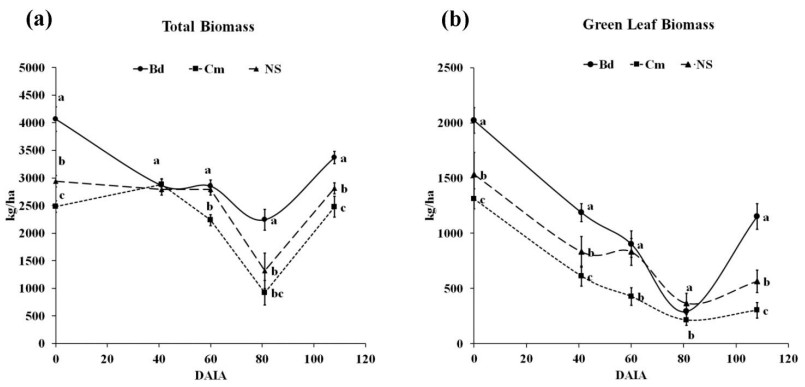









 DownLoad:
DownLoad:
